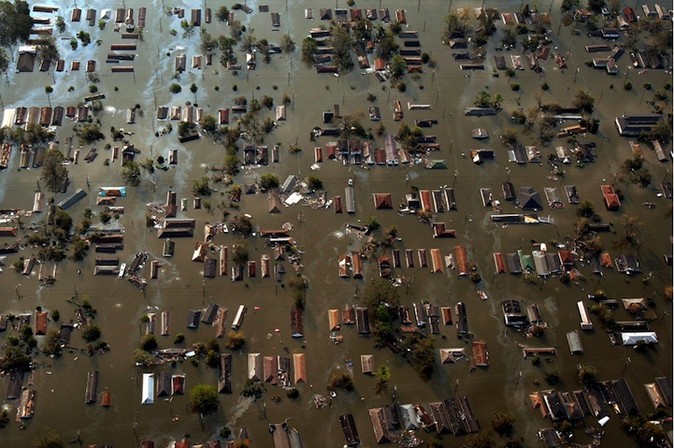The Wrack
The Wrack is the Wells Reserve blog, our collective logbook on the web.
The Wrack is the Wells Reserve blog, our collective logbook on the web.

The following was published in the Biddeford-Saco Journal Tribune Sunday edition, 8/23/2015.
Perhaps a butterfly flapped its wings in Hong Kong, or perhaps the gods who play dice with the sky rolled double sixes. Whatever the cause, the atmospheric disturbance that formed over the southeastern Bahamas on August 23, 2005, would go on to have massive effects.
Like a bowling ball released at the top of a mountain, the storm would bounce through Florida and then gain speed and power in the abnormally warm Gulf of Mexico. By the time Hurricane Katrina was through releasing its many atomic bombs’ worth of energy upon the land, nearly two thousand people would be dead, $108 billion in damages would be wrought, and the unique cultures of New Orleans and other Gulf Coast cities and towns would be altered forever.
Hurricane Katrina was the costliest natural disaster in American history. It wasn’t the largest storm ever recorded, though: compared to the recent super typhoons that have been exploding in the Pacific theater laterly, Katrina at landfall was just a medium storm. Nevertheless, 90% of Mississippi’s beachfront communities were obliterated and half the population of New Orleans still hadn’t returned to the ravaged city a year later.
Why was Katrina so destructive? If we’ve learned anything from the postmortem examinations of Katrina’s and other hurricanes’ destruction, it’s that engineering, preparedness, and response measures matter.
New Orleans flooded because the levees surrounding the city breached. They were built by the U.S. Army Corps of Engineers to supposedly withstand a storm surge from a Category 2 hurricane, but design flaws and a storm surge magnified by other canals contributed to their “catastrophic failure.” According to a findings report by the American Society of Civil Engineers, a perfect storm of cost cutting, ignorance, bad designs and patchwork construction spelled all but certain doom for many of the city’s low-lying neighborhoods.
But if we zoom out beyond the levee system, we should also ask some other questions about engineering choices such as: shouldn’t parking lots for emergency vehicles and buses be located at higher elevations? Shouldn’t cell phone towers, given how crucial they are for communications today, be built to withstand the strongest possible winds? Shouldn’t the entire hurricane-prone region of the Gulf Coast adopt the stricter building codes of South Florida?
The answers to these questions are likely yes, but they carry high costs. It may be easier and cheaper to gamble that hurricanes like Katrina are once-in-a-lifetime events. “At least that will never happen again,” some Gulf Coast residents must have thought in the wake of Katrina.
And then hurricanes Rita and Wilma battered the already knocked-down Gulf later that fateful year, ten years ago. Those were the last major hurricanes to hit the United States. Had it not been for Superstorm-but-not-a-hurricane Sandy in 2012, the latest generation of coastal homeowners might have completely forgotten about the ever-present danger that comes from the sea.
Next week, I’ll ask some personal questions on hurricane preparedness and response efforts. In the meantime, on Thursday, August 27th, the Wells Reserve at Laudholm is putting on a special Hurricane Katrina remembrance concert with the Soggy Po’ Boys, a New Orleans-style jazz band from Portsmouth. We hope to use music and images to remind our friends and neighbors that the storms of the past are but prequels to the future. There’s more information on our website, www.wellsreserve.org.
Nik Charov is president of Laudholm Trust, the nonprofit partner of the Wells National Estuarine Research Reserve in Wells, Maine. His Sunday column, “Between Two Worlds,” ventures forth from the intersection of art and science, past and future, hurricanes and extratropical storms. More at wellsreserve.org/twoworlds.